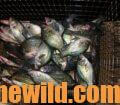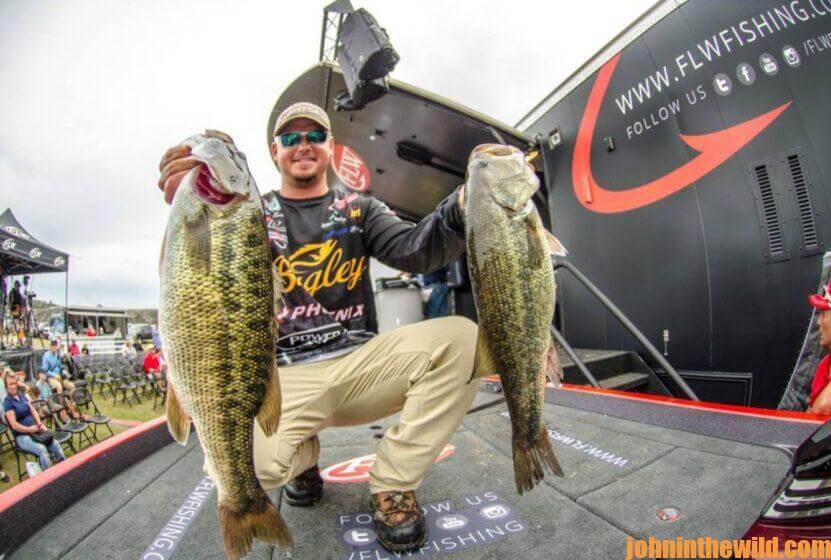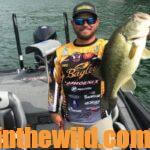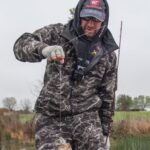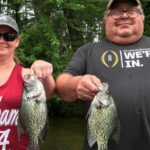Editor’s Note: Thirty-four-year-old Drew Benton from Panama City, Florida, began his tournament fishing career on the FLW Circuit (https://www.flwfishing.com/) and fished three seasons there and then moved to the Bassmaster Elite Series in 2016. He’s earned about $740,000 fishing tournaments. He was named Rookie of the Year in 2016 and won 1st place on Lake Travis in 2018 and $100,000. Benton fished bass tournaments in high school and college, while going to school. Benton’s favorite lakes to fish are Lake Seminole on the Florida-Georgia line and Lake Eufaula on the Alabama-Georgia line. At this time of the year, he’s really comfortable fishing weather 100 degrees or more. I asked Benton how he finds bass in over 100-degree temperatures, and how he catches them.
 The lake determines how I bass fish in hot weather. For instance, is the lake you’re planning to fish a grass lake, is it a deep, clear lake with no structure or grass or is it a riverine-type lake? The kind of lake helps you know where you’ll find fish, and how you’ll catch them. Let’s start off with a grass lake – like Lake Seminole. One of the reasons I’d like to start with Lake Seminole is because it has almost every type of structure you may fish in the summer months. I’ve caught bass on river ledges and in deep water at Seminole. I’ve caught bass there in shallow grass. In Spring Creek on Seminole, I’ve fished grass that’s 20-feet deep. So, what’s good about Seminole for summertime is that an angler has a lot of options of where he can look for bass and bait, giving him several ways on how to catch bass in hot water at this lake. Also, he can try many deep- and shallow-water tactics to catch bass in Seminole.
The lake determines how I bass fish in hot weather. For instance, is the lake you’re planning to fish a grass lake, is it a deep, clear lake with no structure or grass or is it a riverine-type lake? The kind of lake helps you know where you’ll find fish, and how you’ll catch them. Let’s start off with a grass lake – like Lake Seminole. One of the reasons I’d like to start with Lake Seminole is because it has almost every type of structure you may fish in the summer months. I’ve caught bass on river ledges and in deep water at Seminole. I’ve caught bass there in shallow grass. In Spring Creek on Seminole, I’ve fished grass that’s 20-feet deep. So, what’s good about Seminole for summertime is that an angler has a lot of options of where he can look for bass and bait, giving him several ways on how to catch bass in hot water at this lake. Also, he can try many deep- and shallow-water tactics to catch bass in Seminole.
The real key to successful summertime fishing is pinpointing the bait fish. Will the bait be holding in the shallow grass mats, in deep, underwater grass beds, under the lily pads or offshore on underwater ledges? The term bait fish means various things to different people. Bait fish can be shad, bluegills, perch and/or blueback herring. The bass have to feed every day and usually several times a day, and the bait fish represent a plate of good groceries they can feed on whenever they get hungry. For this reason, wherever you find the most bait fish will be where you’ll locate the most bass relating to those bait fish.
With my typical summer patterns. I like to fish early in the morning, right at dawn, in the shallow grass. However, before I begin to fish, I’ll pull up to some shallow grass, turn my big motor off, use my trolling motor to get closer to the grass, cut my trolling motor off and sit as still and quietly as I can. I want to listen to what’s happening in the grass. If I hear a lot of popping (bream that are sucking down and eating shallow critters just under the grass), then there’s a really-good chance numbers of bass are in that same area under the grass feeding on the bluegills. From the amount of popping I hear, I often can tell if there are bream beds under the grass. I’ll use two tactics once I establish the fact that bream are there and possibly other bait fish feeding in the grass. The two techniques and lures I like to use when I’m fishing in this kind of area are: a rubber Thunder Frog and punching through the grass with a heavy weight and a big worm.
Punching Grass Mats:
 Punching grass mats is a form of flipping. You use a heavy lead up the line to punch a hole in the grass for your bait to get through the grass and down to where the bass are. Some anglers prefer a really-heavy weight to punch through the grass, but I prefer the lightest weight I can use that’ll punch a hole through the grass and let my bait fall through the hole. For me, most of the time I’ll be fishing a 1-ounce tungsten bullet weight to punch the hole. In very-thick grass, I’ll use a 1-1/4-ounce tungsten weight to punch a hole.
Punching grass mats is a form of flipping. You use a heavy lead up the line to punch a hole in the grass for your bait to get through the grass and down to where the bass are. Some anglers prefer a really-heavy weight to punch through the grass, but I prefer the lightest weight I can use that’ll punch a hole through the grass and let my bait fall through the hole. For me, most of the time I’ll be fishing a 1-ounce tungsten bullet weight to punch the hole. In very-thick grass, I’ll use a 1-1/4-ounce tungsten weight to punch a hole.
While fishing the grass mats, I like to use a Big Bite Baits YoMama (https://bigbitebaits.com), made by Scott Montgomery in Eufaula, Alabama. I like the YoMama because it’s a solid-bodied, soft-plastic beaver-type bait, which I can Texas rig. The point of my hook usually doesn’t pop out of this bait when it hits the grass or any type of structure under the grass. I use two different colors: tilapia magic, which is basically a green-pumpkin-colored lure with blue and gold flakes; and a hematoma color, which is a black-and-blue color with little red flakes. When I’m punching grass, I like a natural color and a dark color. You also can fish just a green-pumpkin color or a black-and-blue color. However, I believe the flake in the YoMama gives the color a little extra flash. I’m fishing with Seaguar (https://seaguar.com/) 65-pound-test line and a Super Flipper Rod by Phenix (https://phenixrods.com/). This 7-foot, 6 inch long rod is a heavy flipping rod with a high gear-ratio reel. The one I’m using right now is 8.3:1.
To set the hook on a YoMama is to understand what happens when the bass takes the lure, and what happens when you set the hook on the bass. Most often, the bass will take the bait as it falls, so you must watch your line and look for a tick or a twitch as that bait free falls under the grass. This technique tries to get a reaction strike often when the bass don’t want to bite. Remember in hot weather, bass tend to be a little sluggish.
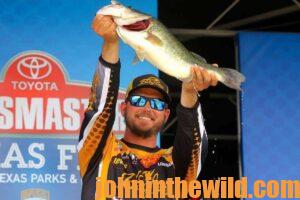 Whenever I see my line twitch or jump, I’ll know that the bass has taken the bait. I’ll reel down on my rod to pick up the slack on the line and try not to set the hook too hard. Don’t forget that up the line is a big, heavy 1-ounce lead, so if you attempt to set the hook hard and fast, you’re causing that lead to slide back to your lure and hit the bass in the mouth. What the bass will do when that heavy lead punches it in the jaw is open its mouth. Then pulling the hook out of the bass’ mouth when the lead causes its mouth to open is easy to happen. Remember that you have a heavy-action rod with a lot of power in it, and you’re transferring that energy to my favorite – a 4/0 jungle flipping hook made by Owner (https://www.ownerhooks.com/product/jungle-flipping-hook/). After I see that I’ve gotten the bite, I take-up the slack in my line, I step back and try to sweep that hook into the bass’s jaw. I’ll snell my hook, so the hook pops-up and most often hooks the bass in the roof of its mouth. Many fishermen try to set the hook really hard, and the number of bass they land with a hard hook set will decrease.
Whenever I see my line twitch or jump, I’ll know that the bass has taken the bait. I’ll reel down on my rod to pick up the slack on the line and try not to set the hook too hard. Don’t forget that up the line is a big, heavy 1-ounce lead, so if you attempt to set the hook hard and fast, you’re causing that lead to slide back to your lure and hit the bass in the mouth. What the bass will do when that heavy lead punches it in the jaw is open its mouth. Then pulling the hook out of the bass’ mouth when the lead causes its mouth to open is easy to happen. Remember that you have a heavy-action rod with a lot of power in it, and you’re transferring that energy to my favorite – a 4/0 jungle flipping hook made by Owner (https://www.ownerhooks.com/product/jungle-flipping-hook/). After I see that I’ve gotten the bite, I take-up the slack in my line, I step back and try to sweep that hook into the bass’s jaw. I’ll snell my hook, so the hook pops-up and most often hooks the bass in the roof of its mouth. Many fishermen try to set the hook really hard, and the number of bass they land with a hard hook set will decrease.
Setting the hook too hard when I first started fishing this technique was one of my downfalls. Even today when I get a bite, I get so excited that I’ll often set the hook too hard, and my bait will come flying out of the water with no bass on the end of it. It’s like a wakeup call to let me know I’ve set the hook too hard to catch the bass. I really just want to sweep the hook rather than jerk the hook when the lure is in the bass’s mouth. I have to remember to let the rod and the line get bait deep into the fish’s mouth, and then all I have to do is get a tight line and pull to catch the bass.
Just because you’ve hooked the bass, doesn’t mean the bass is in the boat. I’m often asked, “How do you get the bass out of the grass?” Well, I use two-different techniques. I keep steady pressure on the bass until I get it on the top of the water, and then I let the bass wallow its way through the grass and on top of the grass, so I can reel it in to the boat. This is the best way to get a bass to the boat.
The next method is to get the bass to the top of the grass, keep it in that ball of grass it’s got on top of its head, and then use my trolling motor to get as close I can to the bass. I’ll reach down with my hand and pull the bass and the grass into the boat. Remember that you’re fishing with a really-sharp hook, and if you pull too hard, the hook will cut a big hole in the bass’s mouth, and your lure will fall out. So, if you can’t get your bass to the top of the mat and out of the grass, don’t hesitate to reach into the water, grab the bass by the jaw, and bring it out of the mat.
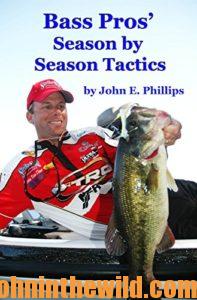 To learn more about catching bass, check out John E. Phillips’ book, “Bass Pros: Season by Season Tactics,” available in Kindle, Audible and print versions at https://www.amazon.com/gp/product/1987482832/ref=dbs_a_def_rwt_hsch_vapi_taft_p7_i4
To learn more about catching bass, check out John E. Phillips’ book, “Bass Pros: Season by Season Tactics,” available in Kindle, Audible and print versions at https://www.amazon.com/gp/product/1987482832/ref=dbs_a_def_rwt_hsch_vapi_taft_p7_i4
You may have to copy and paste this click into your browser. When you click on this book, notice on the left where Amazon says you can read and hear 10% of the book for free. On the right side of the Audible page for this book and below the offer for a free Audible trial, you can click on Buy the Audible with one click.
Tomorrow: Use Electronics, Worms & Crankbaits for Summer Bass

